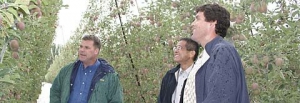
Tony Koselka (right) and Derek Morikawa (center) tell Del Feigal that the orchard Del manages for Auvil Fruit Company is ideal for robotic harvesting.
“I wish the whole industry looked like this,” said Derek Morikawa, chief executive officer with Vision Robotics Corporation in San Diego, California.
“All the fresh fruit industry I wish would look like this,” added VR engineer Tony Koselka.
The company started out developing a robotic harvesting system for citrus but is now working on a similar system for apples.
The Auvil orchard, in particular, would lend itself to robotic harvesting, Morikawa said, because, as well as being visible, the fruit hangs in a single plane. The same factors that make an orchard easy for humans to pick would make it easy and fast for a machine to pick.
Whereas a citrus harvester would need long arms to reach around branches to pick fruit in the interior of the trees, an apple harvester’s arms could be much shorter because all the fruit is within the same reach when the tree is on a trellis. An apple-picking robot might have arms three- to four- feet long, perhaps one for each wire of the trellis.
“When you have uniformity, it’s easy to increase your speed,” Morikawa said. “This all works well for the economics of doing it robotically.”
Platforms
Del Feigal, manager at the 1,050-acre Auvil orchard, uses platforms to move workers more efficiently through the orchard for a number of tasks, but not yet for picking. He hasn’t found a good way to handle the bins when pickers are on platforms, so workers use ten-foot ladders. He hires up to 365 workers at the height of harvest.
Yields this season were running from 80 to 120 bins per acre, depending on the variety. When color picking, workers harvest between five and eight bins per person per day and receive between $25 and $30 a bin. That works out to between $25 and $30 an hour. For picking Granny Smiths, which don’t need to be color picked, the rate is $20 a bin, or $15 to $18 an hour.
Feigal said Auvil Fruit Company has always paid premium rates, because it wants skilled workers. “And we want those people to be here to pick,” he added. “There’s becoming a labor shortage. Everybody’s starting to bring up their prices to get the crop picked.”
Whether Feigal would be interested in a robotic picker would depend on how good the device is at harvesting without damaging the fruit, the tree, or the following year’s crop, he said. “We have to have the quality there.”
As for night picking, Feigal said that would only be beneficial if there was a way to get the fruit to the warehouse at night, so the fruit wasn’t backed up at the orchard the following day.
Labor-intensive
Feigal uses blossom thinning to maintain consistent cropping and pays workers a similar amount for that as for picking.
Morikawa said if the robot could do some of the more labor-intensive jobs, such as blossom or fruit thinning and harvesting, it would be an enabling technology for the industry. It would allow companies like Auvil to do those tasks more economically, but it might also make it more affordable for other growers to adopt such labor-intensive growing systems in order to improve quality or yields.
Feigal grows cherries on a similar system to the one he uses for apples, with the trees trained to a V trellis.
Morikawa said developing a harvester for cherries would be challenging because the trees are big, there are many more pieces of fruit on the trees, and cherries grow in bunches. Human hands have far more dexterity than a robot.
However, a robotic harvester for peaches or pears seems doable, he said. Though the trees are large, the canopies are open, and the fruit is visible.

Leave A Comment